What Do Different Eggshell Colors Mean?
Posted on: March 23rd 2018

- Overview
- How Do Eggs Get Their Colors?
- What Are the Different Eggshell Colors?
- Why Do We Typically Only Eat Brown or White Eggs?
- What Egg Colors Come From Which Breeds?
- Is One Eggshell Color More Nutritional Than the Other?
- What Are the Benefits of Eating Eggs?
- How Do I Buy the Best Eggs If All Eggs Are the Same?
- How Can I Naturally Dye Eggs Fun Colors
- Should I Throw Away Eggshells?
- Why Eggs Are Here to Stay
You may be familiar with “Green Eggs and Ham” by Dr. Seuss. Maybe as a kid, you’ve wanted to try green eggs just like Sam. And now, as an adult, perhaps you’re wondering — Do green eggs really exist? What would make them that color? Do they taste different? Are they more nutritious than a white or brown egg? Does a green egg come from a green chicken?
While green eggs really do exist, they don’t come from green hens. And there’s plenty of other colored eggs that chickens lay outside of the traditional white and brown, like blue! Ready to learn more about the different kinds of eggshell colors and why some eggshells have different colors, as well as how to reuse eggshells throughout your garden and home? Keep reading!
How Do Eggs Get Their Colors?
Before we get into different colors of eggs, let’s take a look at what makes up an eggshell.
An eggshell is made of calcium carbonate, which comes mostly from a hen’s bones. Calcium carbonate makes up nine to 12 percent of an egg’s total weight. The shell has seven to 17,000 tiny pores that allow air and moisture to move through. The outermost layer, called the bloom or cuticle, helps keep out dirt and bacteria.
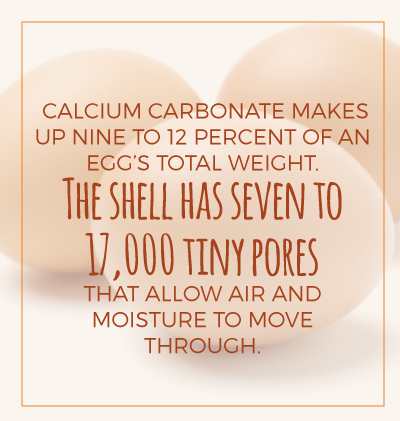
So, how do eggs form? And what determines their colors? It’s a four-step, 24- to 26-hour process:
- The ovary releases egg yolk: Fifteen minutes after a hen lays an egg, egg formation gets rolling once again, though this can vary depending on the breed of chicken. An egg yolk is released from the hen’s ovary and into the oviduct. Sometimes, a hen will release two egg yolks — giving you a double-yolker!
- The yolk travels through the oviduct: An egg yolk passes through a few areas of the oviduct, including the magnum, which is where the egg yolk picks up its egg white, or albumen. After a few hours, the egg yolk and white form two shell membranes, as well as get some water and minerals.
- The shell forms in the uterus: Once the egg, sans shell, reaches its full size in the oviduct, it moves onto the uterus. Here, it forms its shell, as well as bloom and color. For a Rhode Island Red Hen, this will be a brown egg, but for an Ameraucana it’ll be a blue one.
- The hen lays her egg: With its shell formed, a hen is ready to lay her egg in a nice bed of straw. As an egg makes its way out, it can become speckled or streaked. A fast-moving egg means streaking while a slow egg might come out mottled. Younger hens tend to lay smaller eggs, but as they age, their eggs increase in size. The average hen lays 250 to 270 eggs a year, though some are better egg-producers than others.
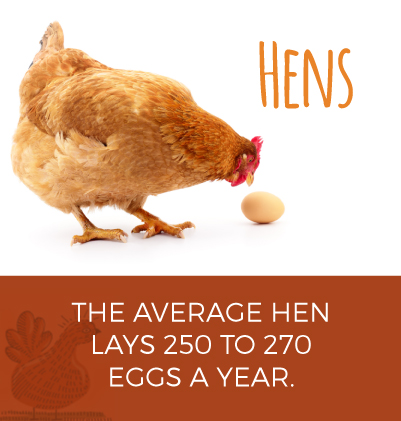
While a chicken’s breed plays a significant role in the color of their eggs, the following two pigments also play a part:
- Protoporphyrin: This pigment produces reddish-brown tones.
- Biliverdin: This pigment creates shades of blue and green.
Not all eggs have the same pigmentation, however. Some are more of a darker green or a lighter brown. Why? A few factors can affect how much pigment a hen deposits on her eggs, including:
- Age
- Diet
- Stressors
Overall, a hen’s genes influence the color of her eggs.
What Are The Different Eggshell Colors?
While white and brown eggs may dominate the supermarket aisles, there are a few other egg colors that hens can lay, including:
- White
White is the most in-demand eggshell color in America. Christopher Columbus is believed to have brought the most famous white-egg — the Single-Comb White Leghorn — to America in 1493. It’s thought that Leghorns originated in Italy.
An interesting fact is that all eggs start out with white shells, no matter the breed of hen. So, next time you hold a blue egg in your hand, realize that it was a pigmentation process that made it that way, because at its earliest stage it was white — like a blank canvas.

- Brown or Brick
What’s a brown egg? Another popular eggshell color choice in America. In fact, New Englanders prefer brown eggs over white. When it comes to nutrition and taste, however, they aren’t any different than white eggs.
During the third stage of the egg-laying process, the hen applies a brown pigment to the eggshell. The pigmentation doesn’t pass through the shell though, as the inside of your eggshell stays white. Again, showing off that all eggs start with a white slate.
Some brown eggs appear to be a shade of orange because of color intensity. Breed, age and stress levels affect the tone and the depth of color. For example, a young hen might lay darker eggs than a more mature hen. Some breeds lay light-colored eggs that might look pink or rosy, while others develop eggs as dark as chocolate.
- Blue
What’s a blue egg? Not an Easter Egg creation! This colored eggshell is becoming more popular among consumers, with its soft-blue marshmallow coloring. Oocyanin, a byproduct of bile production, creates this beautiful color among select breeds of chickens.
Unlike brown eggs, the bluish tint appears early in the egg-forming process. Because the pigment reaches the egg during an early stage, it colors the interior of the eggshell blue too! Therefore, you can expect a blue-shelled egg to be a beautiful blue throughout.
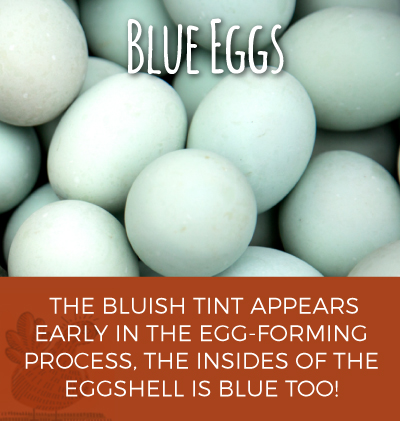
- Green
What’s a green egg? The result of crossbreeding genes from blue eggshells with genes from brown eggshells. These festive-colored eggs are green on the outside and blue on the inside. Only a few chicken breeds can produce this colored eggshell, which makes them a rarer find.
Why Do We Typically Only Eat Brown or White Eggs?
With brown, green, blue and white eggs available, why do most of us only eat brown or white eggs? The reason is that brown and white eggs tend to cost less than blue and green ones. They’re also easier to obtain and usually come from chickens that are known as good egg layers. Plus, they’ve become a part of our kitchen and idea of what eggs should look like.
What Egg Colors Come From Which Breeds?
Throughout history, chickens have been an integral part of human existence. From ancient civilizations to modern times, chickens are considered sacred animals to some, while to others, they are a blank culinary canvas. Their eggs are no exception.
We cannot trace back the exact start date of egg consumption, but history points to the domestication of wildfowl in 3200 B.C. Historians also believe that the fowl were eaten more than their eggs, as the eggs were used to hatch and continue the supply of birds. Egyptian and Chinese records show that birds were laying eggs for humans beginning in 1400 B.C.
So, what are the different breeds that produce colorful eggs? Let’s take a look:
- Leghorns and White Egg-Layers
Remember Foghorn J. Leghorn from Looney Tunes? This breed is the most common white-egg laying chicken in the United States. Originally from Italy and the Mediterranean, Leghorns arrived at the U.S. in the 1800s. The White Leghorn is also the most popular type of leghorn chicken and is the leading egg-producer in the world. They do not possess any pigment genes, which is why their eggs are white!
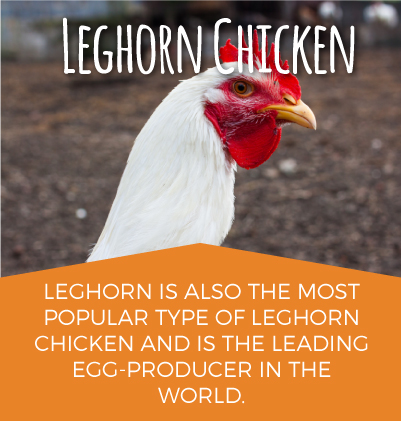
Leghorns can lay anywhere from 150-300 eggs a year. In general, white egg-layers don’t make as good as pets as other breeds because they tend to be nervous. However, their smaller appetites and high egg-laying rate make them the most popular choice for farmers and are a big reason why they are the most common egg color in supermarkets.
Other white egg-layers include:
- Andalusians: While once rare, this breed is making a comeback. Originally from Spain, these chickens lay medium to large white eggs.
- Catalanas: The eggs you purchase in your local grocery are probably not from Catalanas, as they’re rare to find here in the U.S. Their medium white eggs tend to have a creamy tint to them.
- Lakenvelders: Like Catalanas, Lakenvelders aren’t a breed you’ll find in the U.S., though some people do keep them. Lakenvelders hail from Germany and lay medium-sized white eggs.
- Anconas: The Anconas breed, which originates from the Mediterranean, is known for its hardiness. It lays large white eggs that are perfect for a batch of scrambled eggs.
- Minorcas: While known for being an excellent egg layer, Minorcas are becoming less common among farmers. These chickens, also known as the “Red Faced Black Chicken” lay jumbo-sized white eggs.
- Hamburgs: Though they’re called “Everlayers,” Hamburg chickens lay smaller white eggs and tend to be flighty, which makes them more of a labor-intensive chicken.
If you’re wondering what breed lays your white eggs, it’s a safe bet that they’re Leghorns.
- Rhode Island Reds and Brown Egg-Layers
Brown egg-layers are popular breeds for backyard chicken raising, as well as farmers. These dark-feathered birds are calm, plus lay eggs all year-long. Breeds in this category possess the brown pigment gene, protoporphyrin IX, and traces of biliverdin. Eggshell colors can range from a pinkish-brown to a dark chocolate color.
Massachusetts and Rhode Island developed Rhode Island Reds in the early 1800s. Rhode Island Reds are excellent egg-producers. They can lay around 200 to 300 eggs a year. New Hampshire Reds, recognized by the American Poultry Association (APA) in 1935, is a breed that’s separate from Rhode Island Reds.

A few other known brown-egg-laying breeds include:
- Plymouth Rock: Another favorite New England hen, this chicken was developed during the mid-1800s and first exhibited in Boston in 1849. Plymouth Rocks are also knowns as Barred Rocks and lay large brown eggs, plus they’re hardy in colder weather.
- Buff Orpingtons: A well-liked brown egg-laying breed that originated from England, Buff Orpington hens lay about 180 light brown eggs a year. Farmers and hobby farmers love these sturdy birds for their independent character and low-maintenance.
- French Marans: If you’re looking for dark brown eggs, you’ll have to go where the French Marans are. French Marans, originally from France, is rare in the United States. They don’t lay as many eggs as the other breeds, but the color of their eggs is unusual, as they can range from a copper color to a rich, dark brown.

- Australorps: Buff Orpingtons and Australorps are similar, as they’re both loved for their egg laying. Australorps lay around five large, brown eggs per week. They’re also cold hardy, which means they call farms across the U.S. home.
- Delawares: While they lay a bit less than Australorps, Delawares are a dependable breed as they’re a cross between Barred Rocks and New Hampshire Reds. Their eggs are also categorized as large, as well as excellent for an omelet.
- Brahmas: With their feathered feet and medium-sized eggs, Brahmas are a favorite of homesteaders and hobby farmers. Brahmas come from India and are known for their docile nature.
So, who produces the most brown eggs for supermarkets? Rhode Island Reds are a safe bet.
- Araucanas and Blue Egg-Layers
Blue egg-layers typically have red earlobes, just like brown egg-layers, and their feathers can be a range of colors depending on their genes. Breeds in this category lay blue or green tinted eggs because of the pigment biliverdin, which hen’s deposit early in the egg-making process.
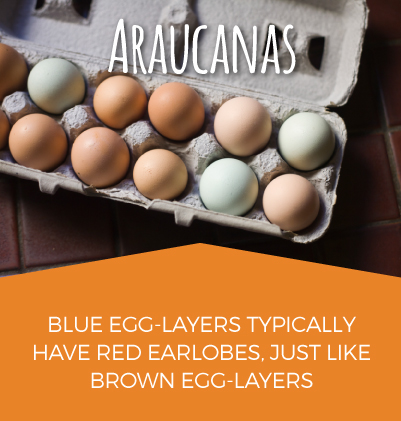
While it’s uncommon to find blue eggs in grocery stores, several breeds lay them, including:
- Araucanas: Historians believe that the Mapuche Indians first raised Araucanas in Chile. These chickens are rare in the United States and are sought-after for their beautiful light blue eggs. Araucanas are not to be confused with Ameraucanas. Although they both lay blue eggs, they are different breeds.
- Ameraucanas: This breed offers extra-large, blue eggs that are an excellent choice for deviled eggs. An interesting fact about this kind of chicken is that poultry shows often feature Ameraucanas. Many hobby farmers also enter other types of well-bred chickens into these competitions.
- Legbars: The ancestors of these hens were brought to England from Chile in 1930 and were bred with Gold Penciled Hamburgs to develop the Cream Legbar eventually. The London Dairy Show in 1947 is when these chickens received their introduction to the world. Since then, they’ve been laying beautiful, medium-sized blue eggs.
- Easter Eggers: They’re considered “mutts” as they’re not a pure breed, but Easter Eggers can lay blue eggs. Due to their breeding, however, they can also produce eggs ranging in colors all the way from rosy pink to sage green.
What do you do if you’re interested in trying a blue egg? Try a local farmer’s market.
- Favaucana and Green Egg-Layers
When it comes to the different eggshell colors available, green eggs are perhaps the rarest. Only a few breeds lay green eggs, and many of them are newer to the chicken world as they’re crosses between top egg layers, like Leghorns and Ameraucanas.

The three breeds that produce green eggs include:
- Favaucana: This new kind of chicken is a cross between Ameraucanas and Faverolles, which features the fluffy cheeks of Ameraucanas, but lays light brown eggs. Favaucanas lay about five, sage green eggs a week, which are a medium size.
- Easter Eggers: Mentioned above, Easter Eggers can also lay extra-large eggs with a green color. This breed looks almost identical to Ameraucanas, which is why they’re often mistaken for them. In most cases, Ameraucanas are usually harder to obtain.
- Olive Egger: Another new breed is the Olive Egger, which is bred from either a Maran and Legbar or a Maran and Ameraucana. These chickens lay about three large eggs a week, which have a beautiful olive-green pigmentation.
While hard to find, the good news about green eggs is they’re the same as white, brown or even blue ones.
Is One Eggshell Color More Nutritional Than the Other?
It’s a common myth that the differences in an eggshell’s color lead to differences in nutritional values. When it comes to cholesterol, calorie and protein values, every egg is the same. The only times these values change is when the egg size differs. A jumbo egg, for instance, is going to have more calories and protein than a small one.
Eggshell color is also unrelated to your egg yolk’s appearance or taste. Diet plays the most significant influence. In fact, a farmer in Santa Fe, Arizona that fed his flock leftover red chiles saw their yolks transition into a sunset-red color. Corn, whether white or yellow, can also cause egg yolks to have a paler or brighter yellow color.
No matter what egg you choose, whether it’s a dozen white, green, brown or blue jumbo eggs, you can trust they’re providing the same nutrition that you need in your diet. What’s egg-cellent about eggs is they’re
compact sources of nourishment.
What Are The Benefits of Eating Eggs?
Eggs are a compact source of nutrition that’s perfect for breakfast, lunch and even dinner — and even hens will agree, trust us, we know from experience. Benefits of having some fried eggs, deviled eggs or a veggie and egg stir-fry, include:
- Offer a wallet-friendly cost.
- Contain low amounts of sodium and zero fat.
- Provide 13 essential vitamins and minerals.
- Include all nine essential amino acids.
- Offer protein.
- Deliver a natural and easy way to manage portion control.
- Promote muscle strength
- Help prevent muscle loss associated with aging and weight loss.
- Support eye and brain health with the antioxidants lutein and zeaxanthin.
- Provide essential nutritional support for expectant mothers and growing children.
With the average large egg providing six grams of protein, starting your day with an egg is an excellent start as men need about 56 grams of protein a day, while women require around 46 grams. Children need 19 to 34 grams of protein each day. Eggs have a lot of protein punch without the high fat and calories of high-protein snacks like nuts and cheese. For better health for you and your family — enjoy more eggs!

How Do I Buy The Best Eggs?
You may be wondering which eggs to buy now that you know that eggshell color doesn’t make a difference. If you want to make sure that you and your family you get the most nutrition, there are a few things you’ll want to look for when purchasing eggs.
Check for these qualities next time you pick up eggs from your local farmer or grocery store:
- Eggs enriched with omega-3s: In the U.S., most Americans do not get enough of this healthy fat, so it’s good to boost your omega-3 intake any chance you get as they improve circulation and lower the risk of heart disease. By feeding chickens a diet that includes omega-3s, their egg’s omega-3s also increase.
- Eggs from cage-free hens: While you can opt to purchase eggs laid by caged hens, more shoppers prefer cage-free eggs as it gives you the assurance that these hens are roaming, roosting and socializing with their fellow flock members, as well as laying their eggs in cozy, quiet nests.
- Eggs that are crack-free: In your spree through the grocery store, it’s easy to forget to check your carton eggs. Just open your carton before adding it to your cart and make sure all your eggs are crack- and leak-free. If you do find any that are damaged, notify an employee so they can remove them from the shelf.
- Eggs that are within their sell-by date: While they’re useful for tons of different meals, eggs can expire if they go unused. And as the saying goes, no one wants to be a rotten egg. So, check the sell-by date on your carton to make sure they’re fresh.
- Eggs stored in refrigerated cases: If you find a carton of eggs sitting among the bread, don’t add them to your cart. You want eggs kept in a refrigerated area, such as where you’ll find your yogurt, cheeses, creamer and other dairy items. And when you get home, make you store your eggs at a temperature of 45 degrees or lower.
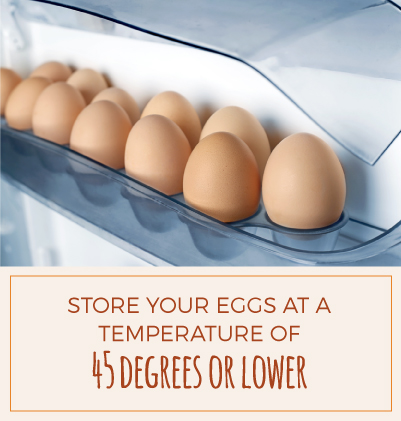
How Can I Naturally Dye Eggs Fun Colors?
While blue and green eggs are hard to come by, you can still fill your basket with a rainbow of colors. And instead of trekking to an Araucana nest in South America, all you have to do is visit your local grocery store and pick up some white or brown eggs.
With some natural dye, you can spice up your Easter Egg hunt, as well as liven up your morning breakfast of hard-boiled eggs, all while saving yourself the trouble of finding real blue or green eggs. After all, the nutritional value is the same, whether a French Maron, Rhode Island Red or Leghorn lays the egg.
Here’s how to make some natural, safe food dyes for your eggs:
- Choose your food dye substance. Red cabbage, turmeric, onion skins, beets or coffee are the best choices for making a food dye. Plus, they’re easy to purchase at your store or gather from leftover meals.
- Place your selected food item in a pot. Use four cups of red cabbage, onion skins or chopped beets. If you’re opting for a turmeric dye, use three tablespoons of For coffee, you’ll want one quart.
- Add your water and vinegar. Pour a quart of cold water and add-in two tablespoons of vinegar to your pot. You’ll then want to turn up the heat, as you’ll need to bring the water to a boil.
- Simmer your mixture. Let your mixture simmer for 30 minutes after your water has reached a boil. You can stir it throughout that time to make sure it doesn’t stick to the bottom of your pot.
- Strain your dye into a bowl. Grab a strainer and place it over a bowl in your sink. Pour your mixed pot of natural coloring into the strainer. Your food remnants should remain in the pan and filter, while the mixture moves into your bowl.
- Let your dye reach room temperature. Give your natural dye some time to cool. Wait around 30 to 45 minutes. It’s essential not to leave your mixture sitting too long, however, as it could become hard.
- Soak your eggs in the dye. Take your eggs and soak them in your natural coloring for about 30 minutes. If you use beets, your eggs will take on a light pink color, while turmeric gives them a faint golden hue and cabbage gives them a blue twist.
- Dry your eggs. You’ll want to be careful when you dry your eggs, as you don’t want to rub the dye off To give them an additional polish, use a bit of vegetable or grapeseed oil.
- Store your eggs. Use a spare egg carton and package your eggs. Place them in your refrigerator, and they’re ready for your next meal, whether it’s a frittata or a set of dippy eggs.
With dyed eggs, every time your family opens the fridge they’ll feel excited to crack open one of these pretty jewels and eat a healthy egg.
Should I Throw Away Eggshells?
If you’ve come across a blue or green egg, it’s understandable to want them to go somewhere other than the trash. Whether you have white, brown, blue or green eggs in your household, you can reuse them for other purposes.
Some uses of eggshells include:
- Feed Your Chickens
Are you raising chickens? You can feed their eggshells back to them — it’s good for them! Hens need an adequate amount of calcium to produce healthy eggs, and eggshells are an excellent source of calcium. They also contain small amounts of sodium, potassium and magnesium.

Here’s how to mix eggshells into your chicken feed:
- Smash the shells down.
- Spread them on a baking sheet.
- Bake them at 350 degrees for five or ten minutes or until they’re dried out and toasted.
- Grind them into a powder with a food processor.
- Mix them with regular feed or put them into a separate feeder.
You can also let your girls have their eggshells plain. In fact, many hens go a bit hog-wild for them.
- Make an Eggshell Powder
No chickens? That’s ok because you can eat your eggshells instead — not as-is, of course. What you’ll want to make is an eggshell powder. You can consume this powder however you wish, although you may like adding it to your favorite dishes, as they don’t change the flavor of your meal, but the texture.
The benefit of consuming eggshells is they give you an extra calcium boost. A study published in the International Journal of Food Sciences and Nutrition found that the shell of one egg contains about two grams of calcium, which is twice the daily requirement for adults. Spread eggshell powder from a single egg throughout the week, and you’ll be good to go.
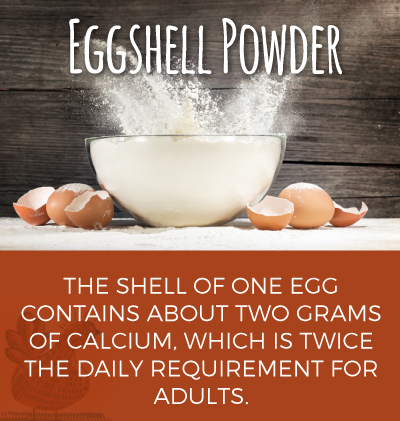
Here’s how to prepare your nutritional eggshell powder:
- Bring eggshells to a boil. Grab a stock pot, add some water and your eggshells and then bring it to a rolling boil — of at least 140 degrees Fahrenheit — for three and a half minutes. This step makes sure you kill any bacteria that may be resting on your eggshells.
- Air dry eggshells. Let your eggshells dry in the sun and cover them with cheesecloth. You can also dry them in the oven on a cookie sheet for an hour at 140 degrees Fahrenheit.
- Grind eggshells. Use a coffee grinder or food processor to get your eggshells down to a fine powder. You can also use a mortar and pestle if you like.
- Store powder. Place your powered eggshells in a sealed container and store them in the fridge. You’ll want to use them within three to four days.
- Measure servings. Because a single eggshell contains twice the daily calcium requirements of adults, you’ll want to make sure you measure out how much powder you use, as you don’t want to overdo it. Using about 5 grams of eggshells should be enough a day.
- Create a Craft Project
Browse Pinterest and Instagram, and you’ll find plenty of craft projects that incorporate not only eggs but also eggshells. Meaning, if you’re not interested in eating powdered eggshells or are without chickens, you still have some recycling options!
Here are a few fun ideas to experiment with in your downtime or to pass a rainy afternoon with the kids:
- Make a succulent garden. You can reuse your egg carton with this project. Build your garden within your container and then fill it with dried eggshell halves. Pour soil and place succulents into the shells for an adorable miniature garden.
- Grow grass or catnip. Add greenery to your home by creating an eggshell planter. For this project, you’ll need to ensure your eggshell is intact, with a single hole at its top or middle. Some families like to grow grass or catnip, as well as draw faces on the egg.
- Turn into a mosaic. Have a bowl of leftover Easter eggs? You can glue their broken shells to a hard surface like a piece of cardboard or a wooden box to give the appearance of a mosaic of ceramic tiles. To go a step further, you can touch them up with paint to create an even more unique look.
With eggshells, there are plenty of ways to use them in a craft project.
- Cultivate Your Garden
Eggshells not only give animals calcium but also plants too. Mixing eggshells with soil at the bottom of a hole will help new plants grow. Your tomato plants will especially love you for it. You can also help existing plants by mixing the eggshells into the soil during the fall and spring.

Next time you crack an egg and get ready to trash the shell, just remember — there are lots of ways to reuse it.
Why Eggs Are Here to Stay
The United States produces 75 billion eggs a year, which is about 10 percent of the world’s eggs. Consumers use 60 percent of these eggs, while the restaurant industry claims nine percent. Products like mayonnaise and cake mix use the remaining eggs. Americans love eggs, and for a good reason. They’re healthy for us, as well as delicious and egg-cellent for a range of meals. Their variety of eggshell colors also makes them nature’s work of art.
The Sauder Family Brings Tradition to Your Frying Pan
If you’re looking for an egg supplier you can trust, look no further. For more than 80 years and three generations, our family at Sauder’s Eggs has been serving fresh and delicious eggs from our home to yours. Whether you’re a lover of red beet, hard boiled or organic eggs, you can count on our family to deliver the large, golden brown eggs your family’s looking for to start their home-cooked morning, lunch or dinner.
And you can rest assured that we care about our hens. We work with all our farmers, who we’ve partnered with for generations, to make sure our hens are safe, healthy and happy. To our family, a healthy hen means a healthy egg, which is why all Sauder Egg’s contain the United Egg Producers Certified Seal and Mark of Excellence that ensures your eggs come from the happiest of hens.
To grab a fresh dozen of eggs, locate one of our stores or contact us!
